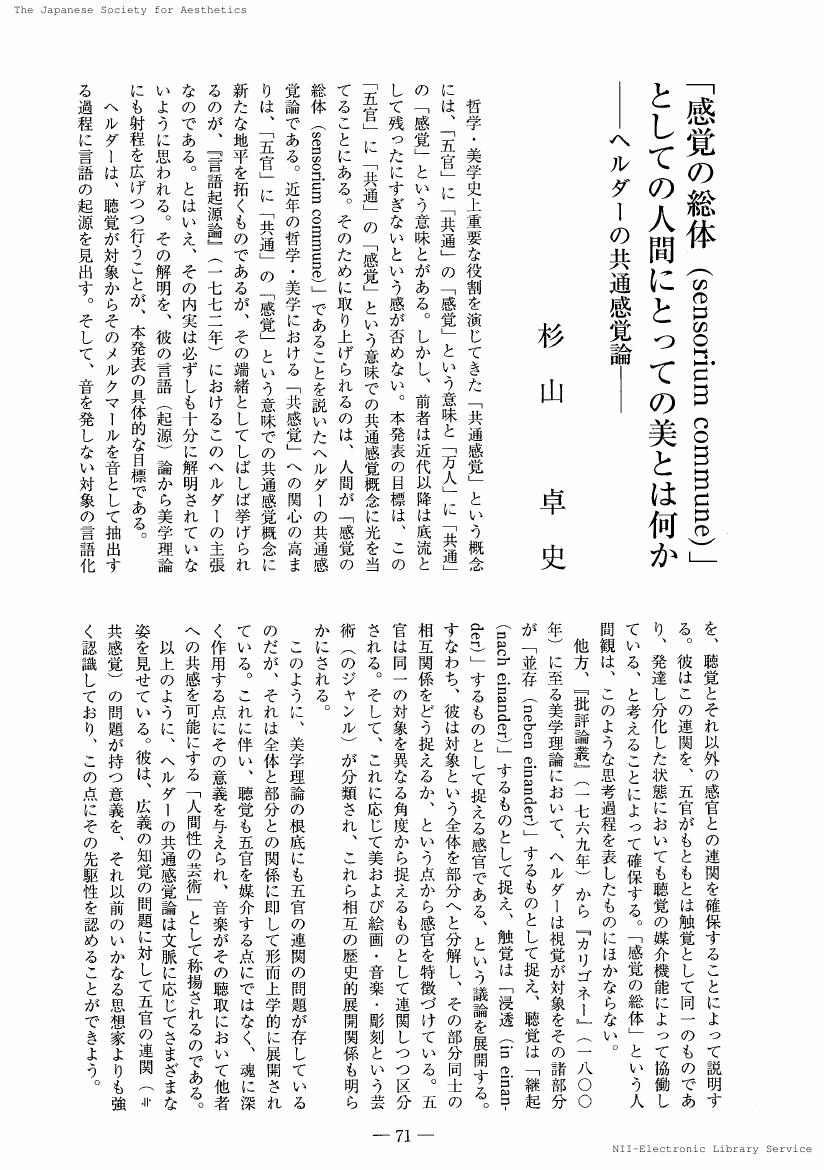2 0 0 0 OA 日常生活の感性論としての貨幣の感性論 : ガブリエルとジンメル
- 著者
- 杉山 卓史
- 出版者
- 美学会
- 雑誌
- 美学 (ISSN:05200962)
- 巻号頁・発行日
- vol.61, no.2, pp.1-12, 2010-12-31 (Released:2017-05-22)
"Alltagsasthetik" ist eines der neuen Gebiete der Asthetik. Das ist ein Ergebnis des seit dem Ende des letzten Jahrhunderts versuchten Verstandnisses der Asthetik als der Theorie der sinnlichen Erkenntnis, welches ihre Gegenstande nicht auf die Kunst und das Schone beschrankt, und sucht das Asthetische aus alltaglichen Dingen zu sehen. Ist das aber bloss Erweiterung der Gegenstande oder Anwendung der Methode der traditionellen Asthetik auf alltagliche Dinge? Auf diese Frage mochte ich in diesem Aufsatz am Beispiel der Asthetik und Rhetorik des Geldes (2002) von Gottfried Gabriel, einer Pionierstudie der "Asthetik des Geldes", antworten. Gabriel versucht aufzuzeigen, wie sich die quantitative Grosse Geld der asthetischen Qualitaten bedient hat. Diese Fragestellung ist deshalb von Bedeutung fur die "Alltagsasthetik", weil sie das Dogma der modernen Asthetik dekonstruieren will, dem zufolge das Asthetische nicht in Materie sondern in Form bestehe. Andererseits behauptet er aber durch den Vergleich der Pfennig-Munzen der BRD und DDR, dass die Kontinuitat der Munzbilder die Abwertung der Munzmaterien ausgleicht. Das ist eine Zuruckziehung von der Materie zur Form. Es ist der Begriff der "Schwelle" in der von Gabriel kritisierten Philosophie des Geldes (1900) und den anderen gleichzeitigen kleinen Schriften von Georg Simmel, der Gabriels Unvollkommenheit erganzt.
2 0 0 0 ヘルダーの共通感覚論 : 共感覚概念の誕生
- 著者
- 杉山 卓史
- 出版者
- 美学会
- 雑誌
- 美学 (ISSN:05200962)
- 巻号頁・発行日
- vol.57, no.1, pp.1-14, 2006
This paper reflects on Herder's concept of "common sense", understood in terms of sense common to all the senses. His saying "we are a thinking sensorium commune" from his Treatise on the Origin of Language (1772) has received increasing attention in recent years as it is thought to be at the origin of the concept of synesthesia. But why so? According to contemporary medical-psychological research, synesthesia is the concrete experience of fusion of the senses located in the limbic system. This means that synesthesia is the opposite of the Aristotelian conception of common sense, because the latter is the faculty to grasp abstract qualities. Herder's "sensorium commune" has a different connotation. By using this expression he meant that all the senses are originally one and the same (=feeling); they become differentiated from this and work together. This level is prior to both the birth of language and the judgment of beauty. Herder is the one who formulated such a conception of common sense, (which is not the faculty to grasp abstract qualities), for the first time in the history of ideas. This is why his "sensorium commune" is at the origin of the idea of synesthesia.
- 著者
- 杉山 卓史
- 出版者
- 京都大学
- 雑誌
- 京都美学美術史学 (ISSN:13471627)
- 巻号頁・発行日
- no.4, pp.157-185, 2005
- 著者
- 杉山 卓史
- 出版者
- 美学会
- 雑誌
- 美学 (ISSN:05200962)
- 巻号頁・発行日
- vol.66, no.1, pp.208, 2015-06-30 (Released:2017-05-22)
1 0 0 0 OA 「われ感ず、ゆえにわれ在り」のヘルダーにおける成立
- 著者
- 杉山 卓史
- 出版者
- 美学会
- 雑誌
- 美学 (ISSN:05200962)
- 巻号頁・発行日
- vol.66, no.1, pp.53-64, 2015-06-30 (Released:2017-05-22)
In On the Sense of Touch and the Fourth Grove of the Critical Forests (both written in 1769, but published posthumously), Herder showed the position "sentio, ergo sum." This paper aims to make clear what led Herder to this position, in order to consider the possibility of "sentio, ergo sum" as an alternative of the Cartesian "cogito, ergo sum." "Sentio, ergo sum" in On the Sense of Touch is, on the one hand, said not only in terms of the "Molyneux's problem," but from the view that it is the highest concept of philosophy to sense the impenetrability of materials, by means of which the precritical Kant, Herder's teacher, criticized the mind-body dualism and claimed to give only the temporary answer "where I sense, there I am." Herder criticized this by the counterexample "mental impenetrability" and upgraded the above "temporary" answer to the "highest concept of philosophy." "Sentio, ergo sum" in the Fourth Grove of the Critical Forests is, on the other hand, the consequence of Herder's formal criticism of Crusius, who criticized "cogito, ergo sum" be "conscius sum me cogitare, ergo sum." "Being" was for Herder the unresolvable concept which we can only sense.
- 著者
- 杉山 卓史
- 出版者
- 美学会
- 雑誌
- 美学 (ISSN:05200962)
- 巻号頁・発行日
- vol.61, no.1, pp.175, 2010-06-30 (Released:2017-05-22)
1 0 0 0 OA ヘルダーの共通感覚論 : 共感覚概念の誕生
- 著者
- 杉山 卓史
- 出版者
- 美学会
- 雑誌
- 美学 (ISSN:05200962)
- 巻号頁・発行日
- vol.57, no.1, pp.1-14, 2006-06-30 (Released:2017-05-22)
This paper reflects on Herder's concept of "common sense", understood in terms of sense common to all the senses. His saying "we are a thinking sensorium commune" from his Treatise on the Origin of Language (1772) has received increasing attention in recent years as it is thought to be at the origin of the concept of synesthesia. But why so? According to contemporary medical-psychological research, synesthesia is the concrete experience of fusion of the senses located in the limbic system. This means that synesthesia is the opposite of the Aristotelian conception of common sense, because the latter is the faculty to grasp abstract qualities. Herder's "sensorium commune" has a different connotation. By using this expression he meant that all the senses are originally one and the same (=feeling); they become differentiated from this and work together. This level is prior to both the birth of language and the judgment of beauty. Herder is the one who formulated such a conception of common sense, (which is not the faculty to grasp abstract qualities), for the first time in the history of ideas. This is why his "sensorium commune" is at the origin of the idea of synesthesia.
- 著者
- 杉山 卓史
- 出版者
- 美学会
- 雑誌
- 美学 (ISSN:05200962)
- 巻号頁・発行日
- vol.56, no.3, pp.71, 2005-12-31 (Released:2017-05-22)
1 0 0 0 カントにおける美学と社会哲学 -ヘルダ-による批判からの再構成-
本年度はまず、研究第一年次(平成16年度)に得られた成果である<『カリゴネー』におけるヘルダーのカント批判の意義は、カントの『判断力批判』における「超越論的」趣味論と人間学講義における「経験的」ないし「心理学的」趣味論との比較検討を促す点に存しており、趣味判断が主観的普遍性を要求するというカントの主張は、この比較検討によって捉え直されるべきである>という見解を承け、この比較検討を実践した。その結果、経験的・心理学的趣味論は人々が考えたことや感じたことを実際に伝達している「社会」という経験的な要素からトップダウン式に、そしてそれゆえ共通感覚概念によらずに趣味を規定する「社会的存在としての人間の陶冶」を意図するものであることが明らかになり、カント美学受容史に新たな理解の基軸をもたらしえた。次いで、研究第二年次に行ったヘルダーの共通感覚論の研究を、視点を変えてさらに継続した。具体的には、その音楽論におけるクラヴィーアのアナロジーに即して「五官」に「共通」の「感覚」と「人々」に「共通」の「感覚」との連関を検討した。クラヴィーアは一方でその内部に調和することもあれば不調和に終わることもあるさまざまな音を生み出す点において人間の快および不快の感情を説明し、他方、自ら音を発するのみならず外からの音に共鳴して新たな音を発しもする点において人間の共感を説明してくれる。もちろん、このアナロジーはヘルダー独自のものではなく、同時代のフランス唯物論者たちも好んで用いたものではあるが、唯物論者でないヘルダーにとってこのアナロジーは、彼がライプニッツのモナドロジーをハラーの生理学を参照しつつ批判的に摂取して形成した「有機的モナドロジー」とでも呼ぶべき独自の自然哲学の表現であった。その意味で、二種の共通感覚の連関の問題は、ヘルダーの思想の中心に位置している。


